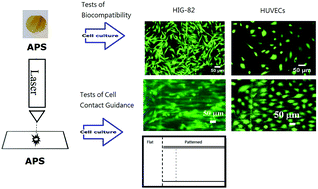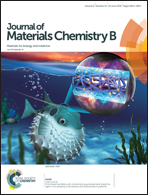Laser-pattern induced contact guidance in biodegradable microfluidic channels for vasculature regeneration
Abstract
The direct cell control by surface topographic patterns in the micrometer and nanometer range has been proven to be important for the maintenance of tissue structures. This study presents the application of direct laser writing to fabricate micro-gratings on the biodegradable material 1,3-diamino-2-hydroxypropane-co-polyol sebacate (APS). The 193 nm excimer laser is applied to form microgrooves with widths of 2 to 10 μm and depths of 400 to 2884 nm. Two kinds of cells, fibroblasts of the rabbit synoviocyte cell line (HIG-82) and endothelial cells of human umbilical vein endothelial cells (HUVECs), were cultured on the flat and patterned APS to evaluate the biocompatibility of APS as well as the influence of contact guidance for cellular behaviours, respectively. The results show that both HIG-82 and HUVECs grow actively on APS scaffolds with directional growth, which was observed through cell morphology and proliferation rate, indicating their applicability in tissue regeneration. HIG-82 was observed to exhibit directional growth with the highest cell spreading area and density on the scaffolds with 7 μm width and 1350–1500 nm depth of gratings. Meanwhile, high cell spreading area and cell density of HUVECs were observed on laser ablated APS with 5 μm gratings and at depths greater than 1485 nm. The proposed microgrooves on APS could significantly enhance the cell growth, adhesion and even promote selective cell proliferation, which poses potential application for further tissue engineering studies.

- This article is part of the themed collection: Editor’s Choice: Scaffold Engineering


 Please wait while we load your content...
Please wait while we load your content...